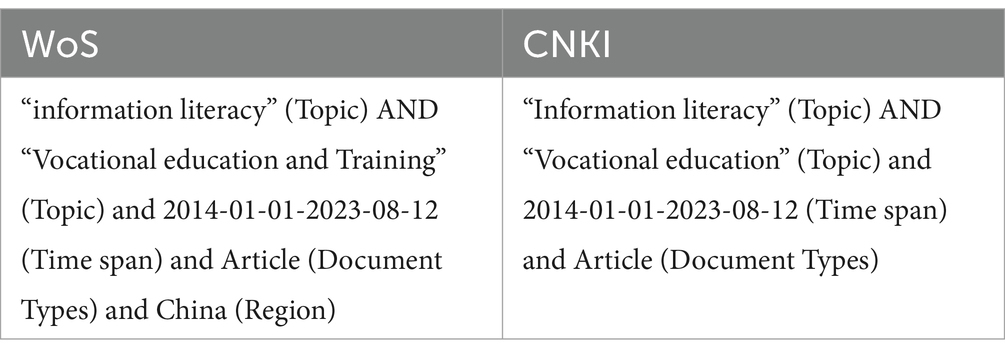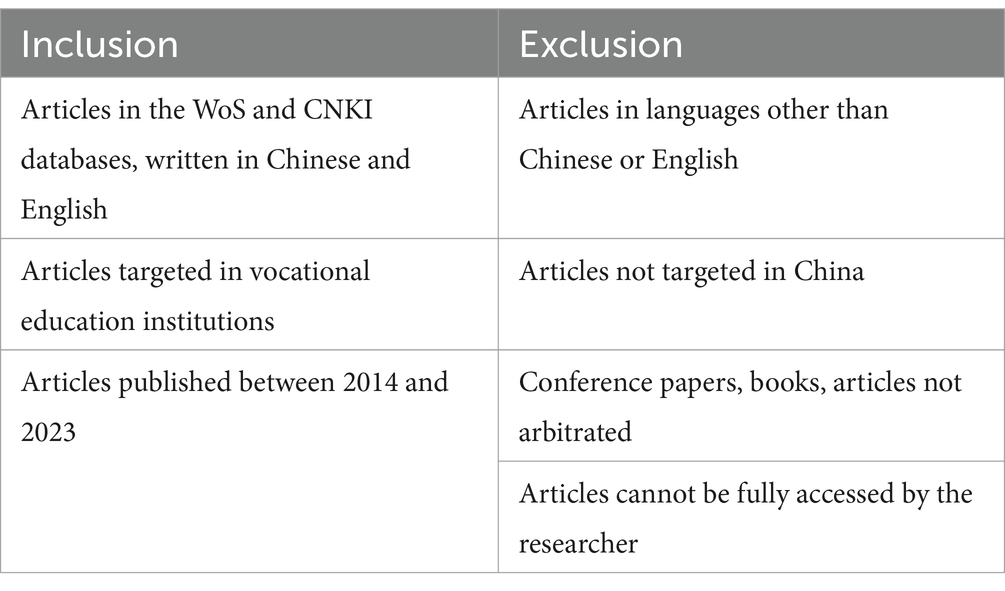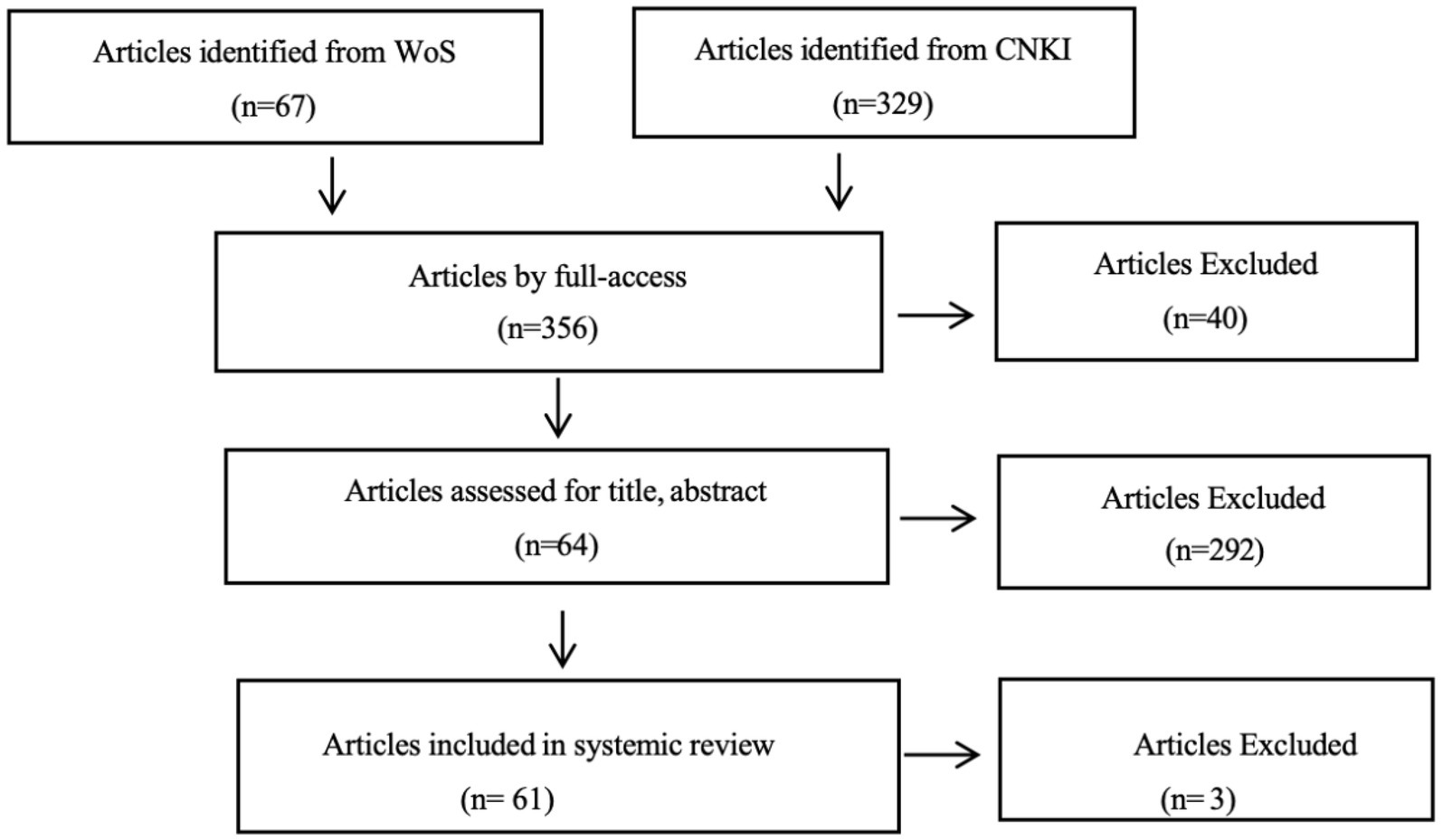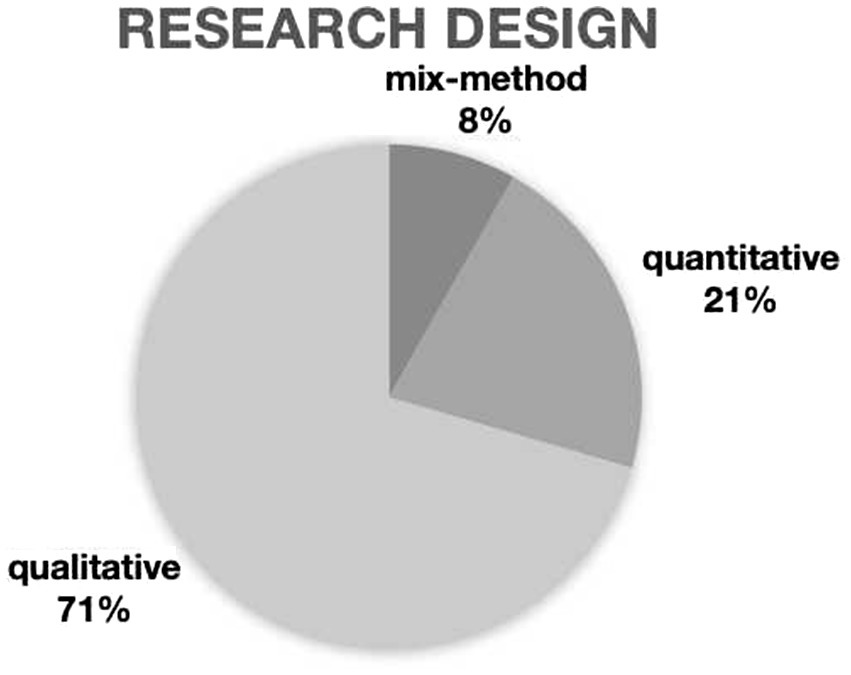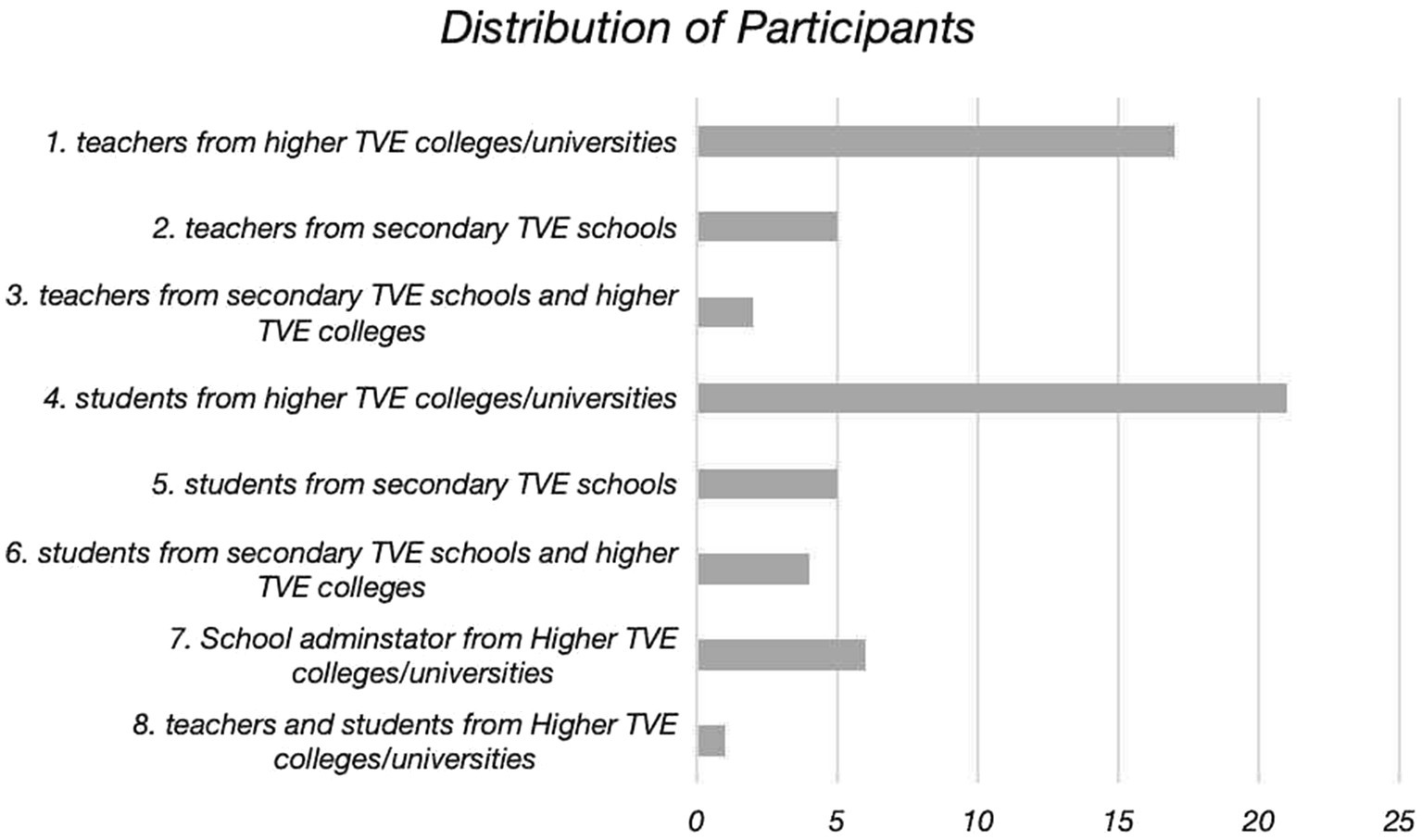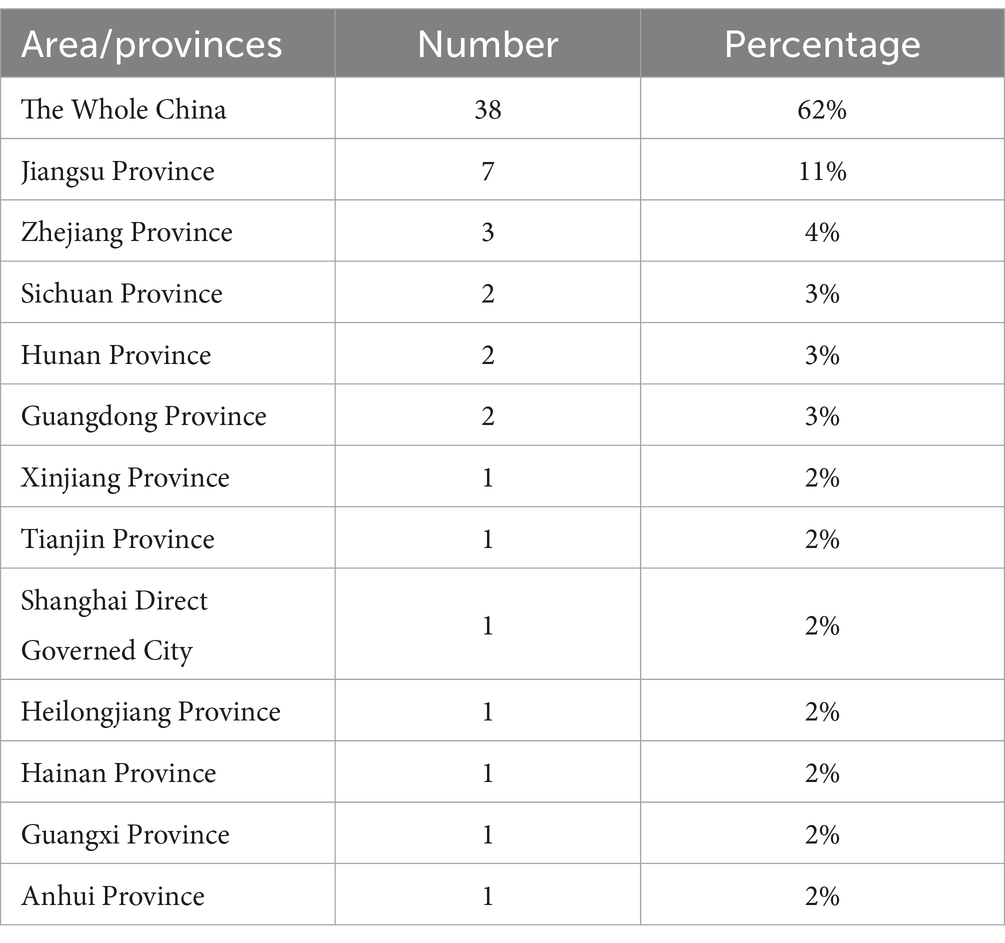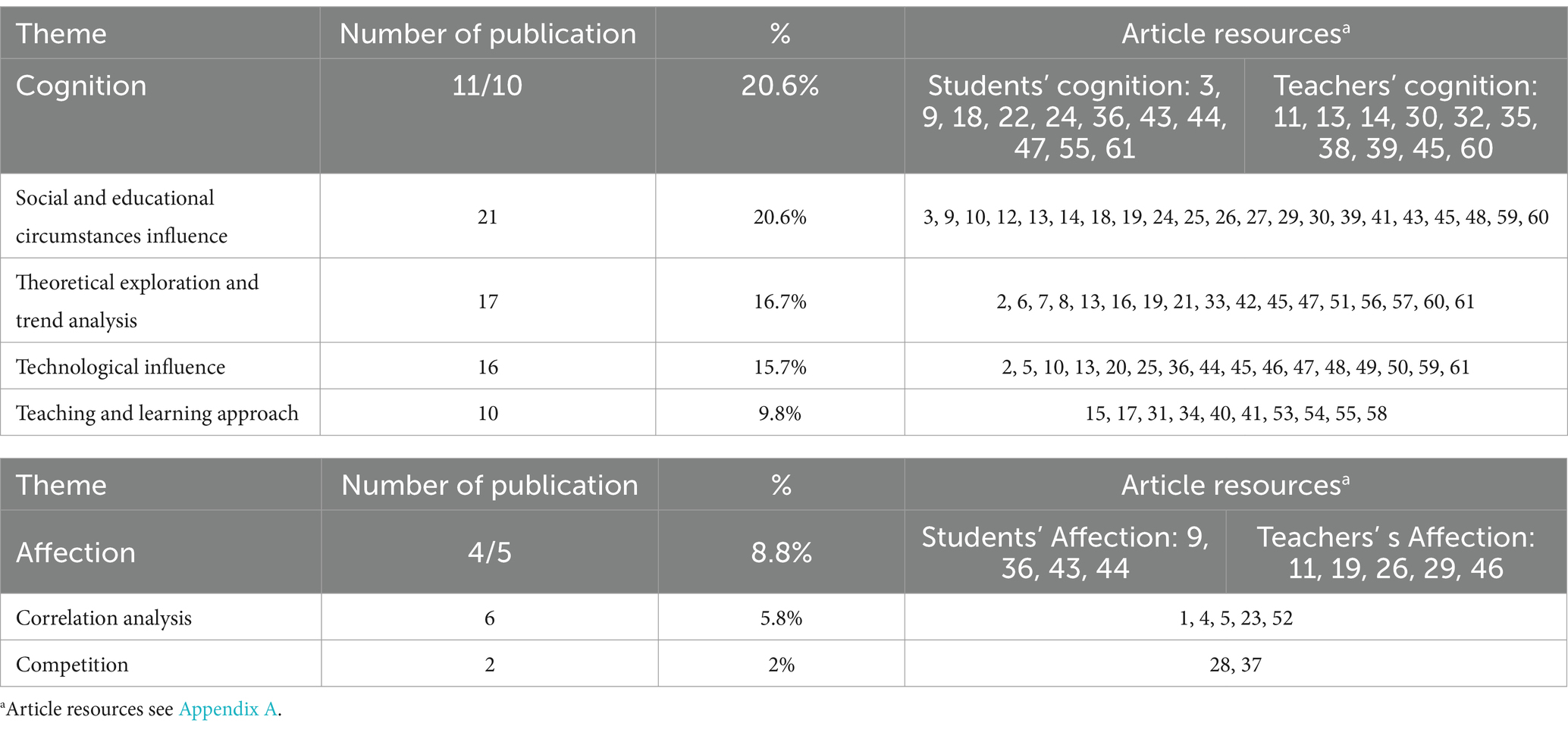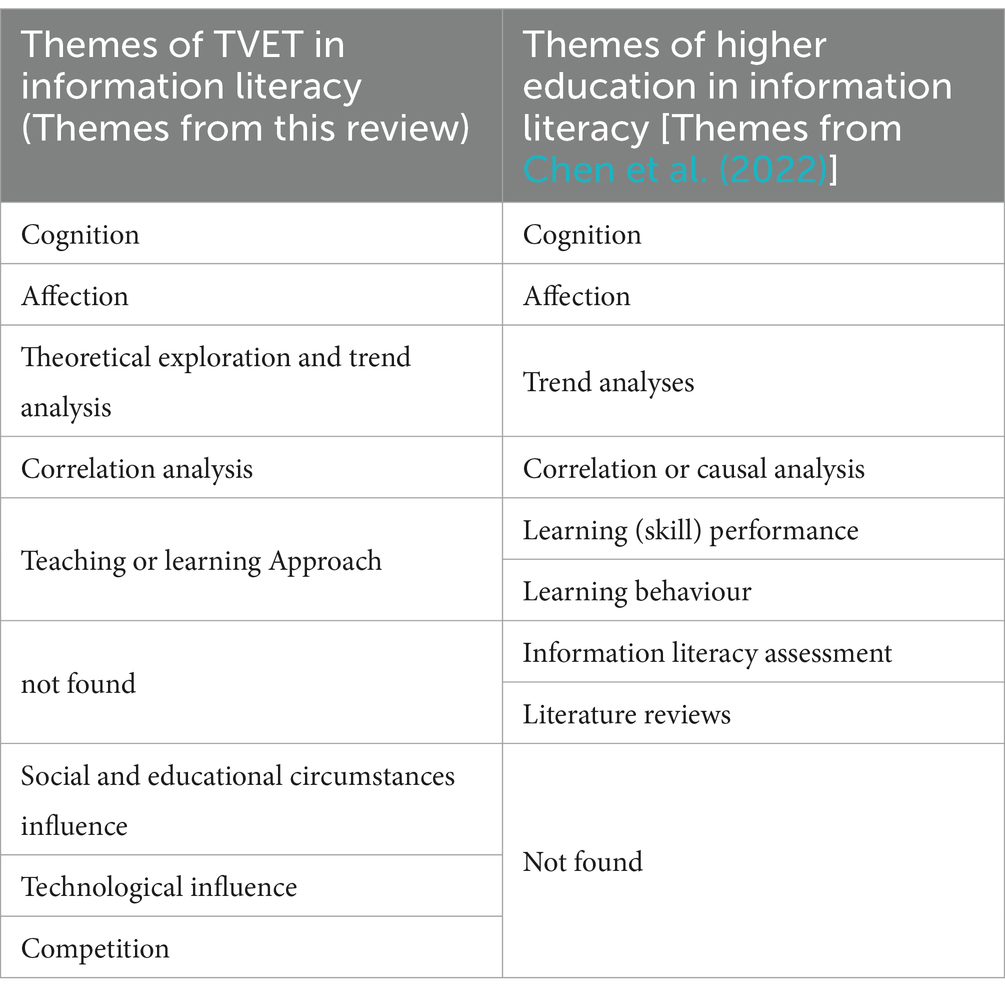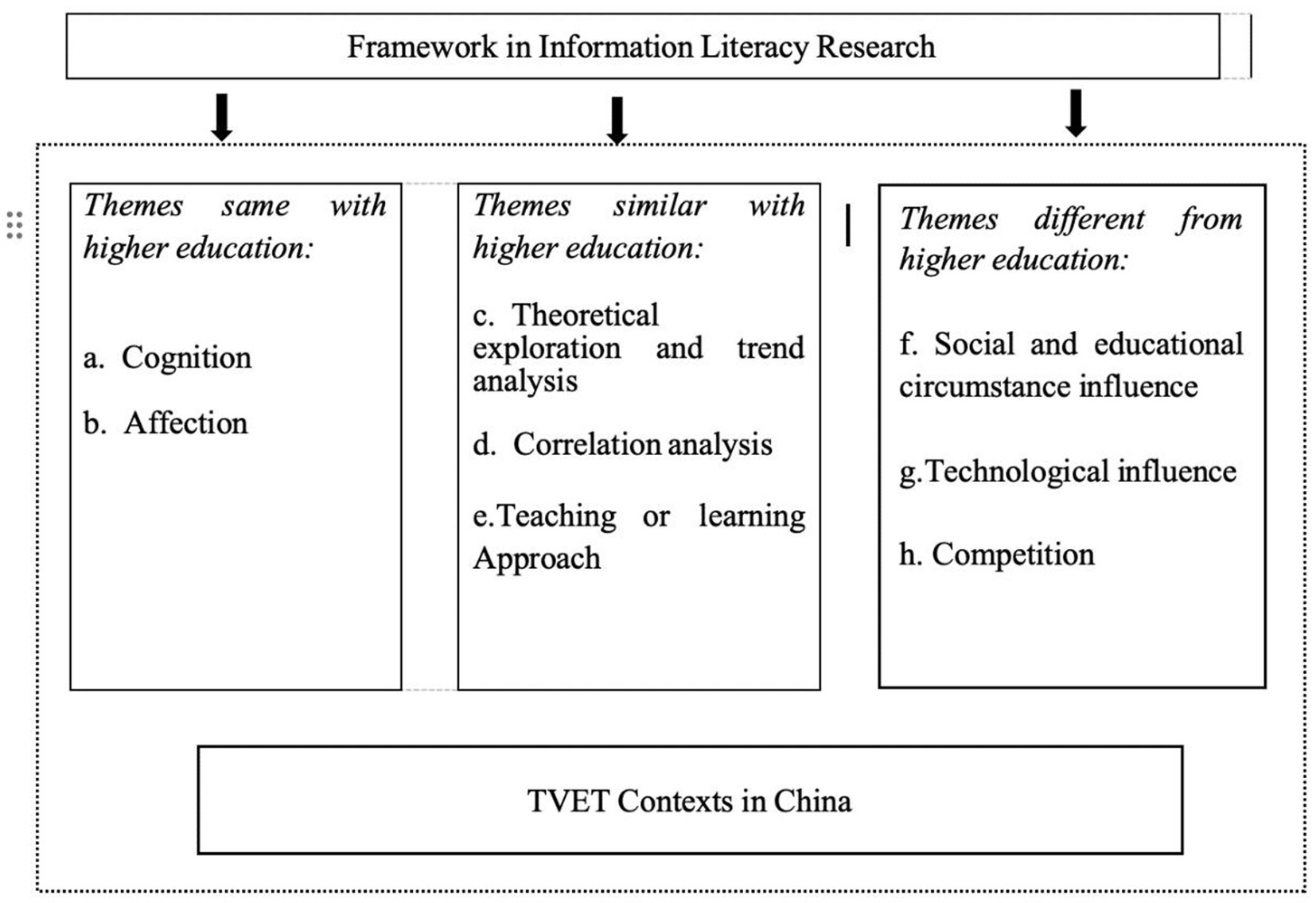- 1Faculty of Social Sciences and Humanities, University of Technology Malaysia, Johor Bahru, Malaysia
- 2Wenzhou Polytechnic, Wenzhou, China
Social and economic systematic changes create a new pattern of industrial structure and profession; technical and vocational education and training (TVET) is deeply connected to industrial upgrading and digital transformation because of its high relevance to cultivate emerging professional talents. Information literacy inevitably becomes the prevailing condition of sustainable development of TVET. Through a literature study, this systematic review selected and studied 61 journal articles related to information literacy in the TVET context in China from Web of Science (WOS) databases and China National Knowledge Infrastructure (CNKI) between 2014 and 2023. The main findings include; (a) technological, social and educational circumstances influence which receive extensive attention from researchers, (b) frequent use of narrative inquiry method with lack of empirical studies, (c) themes identified of information literacy among TVET institutions in China shows significant differences as compared to the themes of information literacy in higher education, and the reasons underlying this finding has been critically analysed. This review may interest academics, decision-makers and trainers in improving information literacy education among TVET institutions in China in line with the sophisticated demands of the industry and community.
1 Background
Realistic expectations related to information literacy of technical and vocational education and training (TVET) programs are deemed important due to the quick growth of information technology, the information explosion, information overload, and significant changes in the social work system.
Over the previous decades, scholars across the globe have made efforts to investigate the issue of information literacy in TVET in different settings such as Malaysia (Ling, 2023), Thailand (United Nations Educational, Scientific, & Cultural Organization, 2016), and Nigeria (Akinseinde, 2020). China is not immune to this trend (Diao and Hu, 2022; Zouliatou, 2017). Nevertheless, to the best of our knowledge, there is currently no systematic understanding of information literacy research in TVET in China.
Thus, bibliometric analyses and systematic reviews are crucial to track trends in the field of research related to information literacy in higher education (Pinto, 2015; Pinto et al., 2020). In the context of TVET institutions in China, this study explored the current research streams and outcomes developing information literacy in this field.
Specifically, this study aims to analyze the extant studies pertaining to the subject of information literacy in vocational education within China. A set of questions was formulated to steer the review process, drawing from various elements aimed at identifying research participants, research methods, and instruments employed in these practices. The resulting findings are anticipated to offer valuable insights to other researchers keen on exploring this subject matter (Moher et al., 2015).
Based on the previous context and introduction about information literacy among TVET institutions in China, this paper is going to address the following research questions (RQs):
RQ1: What methods have been used in researching information literacy among TVET institutions in China? In particular, what research design, research instruments and data collection methods had been used in these studies?
RQ2: Who were the participants as identified in the research conducted in relation to information literacy in technical and vocational education in China?
RQ3: Which area/province in China that these studies conducted the research?
RQ4: What themes were found in the past 10 years of research in relation to information literacy among TVET institutions in China? What are the similarities and differences between higher education and TVET?
1.1 Information literacy
The concept of “information literacy” originated in the 1970s. Zurkowski (1974), then president of the American Information Industry Association, first proposed the concept of information literacy and defined it as specialised training for mastering information tools and developing the skills to solve problems by using information resources. In a broader historical and contemporary context, the digital survival skills of citizen in the information society has shifted the goal of talent development from traditional reading, writing, and arithmetic to critical thinking and problem solving, effective communication, team co-creation, creativity and innovation (Partnership for 21st Century Skills, 2006). Information literacy is the essential and fundamental support for the above abilities and is the basic literacy that every citizen should have in a new era. With the rapid creation of information, “individuals must be able to use the skill of information literacy with a strong belief and high confidence level” (Hee et al., 2019).
The framework or model of Information Literacy has been developed by researchers or organizations to make the concept of information literacy more concrete and clearer. According to previous research, there are two perspectives on information literacy framework/model research. One is process-oriented, which focuses on exploring the process of information problem-solving. The representatives of this type of information literacy theory/model are Eisenberg & Berkowitz’s Big Six Model, Kuhlthau’s Information Search Process (ISP) model, and Neuman’s I-Learn model. The Big 6 model facilitates a structured process aimed at locating, employing, applying, and assessing information to address specific needs and tasks. Widely recognized and adopted, the Big 6 serves as a prominent method for imparting information and technology skills in educational institutions, spanning both schools and HEIs globally. The Information Search Process (ISP) model, akin to the Big Six model, delineates the information search process into six distinct steps. These steps include initiation, selection, exploration, formulation, collection and information search closure. The I-LEARN model serves as a learning framework designed to facilitate students’ engagement in the research and critical thinking process. This model comprises six key elements: identifying, locating, evaluating, applying, reflecting and knowing.
The other perspective of information literacy framework/model is objectives-orientated. The representatives of this type of information literacy theory/model are the Information Literacy Model developed by Chartered Institute of Library and Information Professionals (CILIP), Seven Pillars of Information Skills core model for Higher Education developed by The Society of College, National and University Libraries (SCONUL), and the Framework for Information Literacy in Higher Education developed by The Association of College & Research Libraries (ACRL). The information literacy model developed by CILIP contained eight competencies that a person requires to be information literate, which: a need for information, the resources available, how to find information, the need to evaluate results, how to work with or exploit results, ethics and responsibility of use, how to communicate or share your finding, how to manage your findings (CILIP, 2018). SCONUL introduced the Seven Pillars of Information Skills core model for higher education in 1999 and was revised in 2011. The seven pillars are: identify, cope, plan, gather, evaluate, manage and present (SCONUL, 2011). The ACRL Board adopted the Framework for Information Literacy in Higher Education which consists of six main ideas: Authority is Constructed and Contextual, Information Creation as a Process, Information Has Value, Research as Inquiry, Scholarship as Conversation, Searching as Strategic Exploration.
This section discusses the concept of information literacy and several well-known information literacy theories and frameworks in past research. The following section will focus on information literacy among TVET institutions in China.
1.2 Information literacy in China’s TVET
TVET institutions are an essential platform for teaching the next generation valuable skills. TVET is a broad category of specialised training in the educational setting that connects classroom learning to real-world application (Jacob and Grubb, 2003; Majumdar, 2021).
In Chen and Yin (2023) highlighted that TVET was becoming more closely aligned with the national development goals of industrialization and informatization. This alignment played a crucial role in transforming and upgrading the federal industrial structure through innovation and integration.
Compared to conventional higher education, TVE is based on the logic of technology application and skill training, highlighting the application and implementation of professional technology, development and improvement, operation and management, and the actual process of skills training, comprehensive training, and certificate assessment, emphasising on students’ hands-on skills (Li and Gou, 2022).
TVET in China has existed more than 100 years since Mr. Huang Yanpei, the pioneer of modern vocational education, founded the Chinese Vocational School in 1918. Since the 18th Party Congress in 2012, China’s vocational education has shown a promising trend of significant reform and development. “The 14th Five-Year Plan” (2021–2025) has put forward the critical requirements of “implementing modern vocational education quality improvement plan” and “enhancing the adaptability of vocational and technical education. Dovetailing with the new economy, new industry, new technology and new career development, in 2021, the China’s Ministry of Education promulgated a new version of the “Catalogue of Vocational Education Majors” to meet the industry’s requirements for different levels of vocational education talent training (Ministry of Education of China, 2021).
By the end of 2022, there are 9,752 secondary TVE schools and 17.84 million secondary TVE students in China, accounting for 39.67% of the senior high school students overall in China. China had 1,521 higher vocational colleges (including vocational universities) with an enrollment of 5.46 million students in 2022, exceeding the enrollment of general undergraduates for four consecutive years (Ministry of Education of China, 2023). Henan, Guangdong and Jiangsu are the three provinces with the highest vocational colleges, with 110, 93 and 90 higher vocational colleges (including vocational universities), respectively (Sohu, 2023).
According to the Catalogue of Vocational Education Majors (2021 Edition),” there are 19 major categories of higher TVE, as among them are finance and trade, tourism, culture and art, and news and communication (Ministry of Education of China, 2021). The rise of the 21st century has underscored the growing significance of information literacy and digital competency, brought about by the widespread adoption of the Internet and new technologies (Blau et al., 2020). In China, information literacy education in TVET involves not only students and teachers but also technicians, administrators and resource managers. The roles of different participants in information literacy education cannot be ignored. Reflective practice, akin to narrative inquiry, is a frequently employed research method among Chinese scholars. Narrative inquiry involves documenting the experiences of an individual or small group, elucidating their lived experiences or distinct perspectives, thereby showcasing unique insights and fostering a deeper understanding (Deakin University, 2022).
TVET students face a variety of challenges, including information overload and other issues as members of the information society, learning difficulties brought on by the “Internet + vocational education” paradigm as students, and the need for lifelong learning due to the social work system’s constant change as future workers. These three issues together enhance practical standards for vocational school students’ information literacy, which is the essential literacy of the information age.
Since TVET has attracted much attention from the government, different provinces, and others, this review will focus on information literacy among TVET institutions in China. Information literacy is precisely the comprehensive embodiment of an individual’s ability to handle information in the face of the digital age, and it is an indispensable element in cultivating TVET talents. The review analysed studies that have been carried out in this regard and their main findings related to the issues of information literacy among TVET institutions in China. What were the main research topics? What conclusions were obtained? Are there any TVET characteristics presented? These questions were raised, and answers were expected to be found through a systematic review of related studies.
2 Methodology
2.1 Systematic review
TVET and higher education quite overlap and have similarities. But TVET has its features and is a form of education rather than a level of education. Chen et al. (2022) reviewed the top 100 cited articles on information literacy in higher education published from 2011 to 2020. Therefore, theme categorization from this review is hoping to find similarities and differences between higher education and TVET in information literacy research.
Chen et al. (2022) concluded eight significant themes: 1) cognition, 2) affection, 3) learning (skill) performance, 4) learning behaviour, 5) correlation or causal analysis, 6) information literacy assessment, 7) literature reviews and 8) trend analyses. Chen et al. (2022) have summarised the classification of information literacy in higher education. Based on this context, this review plans to systematically review TVET in China to see what are the similarities and differences as compared to conventional education. Therefore, this systematic review was conducted based on the preferred reporting items for systematic review and meta-analysis (PRISMA) guideline, as presented in the following subsection (Moher et al., 2015).
2.2 Searching strategy and data screening process
In China, there are two important academic sources which have been widely used by researchers and scholars: Web of Science (WOS) and China National Knowledge Infrastructure (CKNI).
WoS is a database with resources focusing on specific subject areas and regions to support systematic and literature reviews (Singh et al., 2021). WOS is widely used by the Chinese governments and universities and colleges as the key reference for academic evaluation (Shu et al., 2019).
CNKI is China’s most prominent digital database for getting abundant research sources from Chinese researchers (Cao et al., 2002). Given the above reasons, WOS and CKNI were selected as the two main databases for this systematic review.
The search in this research was conducted based on criteria in the WoS and CNKI databases because many relevant research papers are commonly published in these two databases. The publications were chosen based on inclusion criteria, which included a publication period spanning from 2014 to 2023, and focused on information literacy within TVET institutions in China (see Table 1).
Articles not arbitrated or fully accessed were excluded, articles published in languages other than Chinese and English were excluded, and articles not targeted in China were excluded (see Table 2).
Cross check among co-authors is a valuable strategy for promoting validity (Johnson and Christensen, 2014). According to the search string, 67 articles from WoS and 329 articles from CNKI were found. Through discussion of all articles based on the established criteria, this review underwent cross check among co-authors of this study, ensuring rigor in the selection and assessment process. Ultimately, 61 articles meeting the specified criteria were identified, all sourced from CNKI (see Figure 1).
3 Findings
According to the research questions, this part displayed findings from four aspects: research method, research participants, research area/provinces, and research themes.
3.1 The use of research method
Concerning research design, as indicated in Figure 2, most of the studies used qualitative methods (43, 71%), followed by quantitative methods (13, 21%) and mixed methods (5, 8%).
Concerning research instruments and data collection methods, narrative inquiry (41, 62%) was the most commonly used research instrument, contributed by forty-one qualitative research methods, followed by questionnaire (18, 27%), contributed by 13 quantitative method research and five mix-method research design. Questionnaire was the only research instrument used to collect quantitative data through online and offline methods, such as a software called “Wenjuanxing,” distributed through emails and paper questionnaires.
Qualitative interview (7, 11%) was another qualitative research instrument used, which contributed by two qualitative method researches and five mix-method research design.
3.2 Research participants as identified in studied documents
TVET is divided into two stages in China, secondary TVE and higher TVE, with secondary TVE corresponding to the senior high school education stage and higher TVE related to the higher education stage. After specific examinations and selections, students from ordinary junior high or secondary TVE schools enter higher TVE colleges/universities.
As indicated in Figure 3, the most common participants as found in the studied documents were students from higher TVE colleges/universities (21, 35%), followed by teachers from higher TVE colleges/universities (17, 29%), school administrators from higher TVE colleges/universities (6, 9%), teachers from secondary TVE schools (5, 8%), students from secondary TVE schools (5, 8%), students from secondary TVE schools and higher TVE colleges (4, 6%), students from secondary TVE schools and higher TVE colleges (2, 3%), teachers and students from higher TVE colleges/universities (1, 2%).
3.3 Area/province
Thirty-eight articles targeted the whole of China, which took 62%. Twenty-three articles targeted particular provinces, and 12 provinces/directly governed cities were mentioned in articles out of thirty-four in China.
As shown in Table 3, the largest number of articles was discovered in Jiangsu Province (7, 11%), followed by Zhejiang Province (3, 4%), Guangdong Province (2, 3%), Sichuan Province (2, 3%), and Hunan Province (2, 3%). Additionally, each of the remaining seven provinces/direct governed cities contributed one article, respectively.
3.4 Findings of themes
Articles on information literacy among TVET institutions in China discussed research topics related to cognition (21), followed by social and educational circumstance influence (21), theoretical exploration and trend analysis (17), technological influence (16), teaching and learning approach (10), affection (9), correlation analysis (6) and competition (2). Table 4 lists the number of publications under each theme and article resources.
Chen et al. (2022) conducted a review of the top 100 cited articles on information literacy in higher education, spanning from 2011 to 2020. This research is a globally oriented analysis of literature on information literacy in higher education. Comparing the article topics of Chen et al. (2022) with those reviewed in this paper, two themes were the same, and three themes were similar. Furthermore, distinguishing from Chen et al. (2022) categorisation of article themes, this paper proposed three new themes based on the content of the articles being reviewed, which were social and educational circumstance influence, technological influence, and competition. A comparison of themes between higher education and TVET is listed in Table 5.
4 Discussion
Based on the research findings, this section explored the trends, reasons and connections of information literacy research in the context of TVET institutions in China.
RQ1: What research methods have been used in researching information literacy in TVET in China? In particular, what research design, research instruments and data collection methods had been used in these studies?
Quantitative studies were not effectively used in this research area compared to qualitative studies, which were only about 30% of the reviewed articles.
Narrative inquiry was the most commonly used qualitative research method in this research area, which related to the researcher’s personal experience. Many researchers in China were willing to use this method to summarise their observations and experiences reflectively, and Chinese journals commonly accept articles using the narrative inquiry research method. This research method has its merits and reflects a certain degree of realism and operability. For example, Ma (2020) analysed the influencing factors of teachers’ information literacy and provided an evaluation pathway based on his rich teaching experience in higher TVE colleges. However, this type of research tends to be less generalisable because of the lack of sample size.
Although TVET in China has more than one hundred years of history, it has not been well-researched with extensive quantitative data. Therefore, empirical study should be encouraged in further research to understand literary information among TVET institutions in China on a larger scale and with an objective scope.
Regarding the research instrument, it was found that the questionnaire was the only research instrument used to collect quantitative data.
Due to its extensive population and vast geographical distribution, questionnaires have emerged as the predominant research instrument utilized by Chinese researchers. This method enables efficient data collection and remains unaffected by geographic factors. For example, Wang (2020) investigated 203 higher TVE teachers nationwide, Ye (2019) surveyed 100 higher TVE students from Heilongjiang Province, and a large scale involving 1,200 higher TVE students from Jiangsu Province were conducted by Tian et al. (2022), all of them used an online questionnaire to collect quantitative data. Meanwhile, the interview was the only research instrument to collect first-hand qualitative data. For example, Zhu (2021) interviewed 15 higher TVE students from Zhejiang Province online and face-to-face and Wu (2021) conducted face-to-face interviews with students from secondary TVE schools in Guangdong Province. Both researchers used interviews to collect qualitative data for their mixed-method research.
From the reviewed articles, it is evident that the research designs and instruments employed by researchers were relatively simplistic. This suggests that researchers may not have possessed comprehensive proficiency in research methodology.
Therefore, future researchers need to improve their ability to use appropriate research methods and instruments to reach their objectives.
Meanwhile, the reliability and validity of research instruments were seldom a concern to Chinese researchers; only a few articles mentioned the process of testing the reliability and validity of the research instruments and their conclusions. Therefore, future researchers in this field need to pay more attention to the reliability and validity of the research instruments to obtain more accurate data.
RQ2: Who were the participants as identified in the research conducted in relation to information literacy in technical and vocational education in China?
Students were primarily common participants, taking about half of the total. The majority of researchers targeted students from higher TVE colleges/universities. The sample size of most studies with students as survey respondents is relatively large, about 200–1,000 students, related to the large number of students in vocational education in China. For example, Zhu (2021) investigated 203 higher TVE students from Ningbo Polytechnic, and Tian et al. (2022) examined 1,200 higher TVE students from Jiangsu Province.
Teachers comprised more than 1/3 of the participants, and articles targeting teachers from higher TVE colleges/universities were more heightened than those from secondary TVE schools. Most of the studies explored teachers’ cognition about information literacy and teaching methods of information literacy education. Two relatively large surveys came from Kong (2021) and Xi et al. (2023). Both studies targeted teachers from higher TVE colleges/universities across the country, and the number of respondents were 480 and 2,381, respectively.
School administrators from TVE colleges/universities also took a small portion of the participants, among them are school management teams and librarians. Most studies were trend analysis and used narrative inquiry research method; and the sample size is not clearly stated in the articles.
In China, there are about six times as many “Zhongzhi” school (secondary TVE schools) as there are higher TVE colleges/universities, and the number of students was roughly equal by the end of 2022 (Ministry of Education of China, 2023). However, when categorising participants from different TVE education levels, participants from higher TVE colleges/universities are about three times as many as those from secondary TVE schools. This research phenomenon may be related to China’s national conditions.
The general public and parents often perceive vocational education as a career path suitable for individuals with lower academic qualifications. Consequently, a significant portion of research attention has been directed towards general high school education, leaving “Zhongzhi” as a relatively overlooked research object.
However, as mentioned in the introduction, “Zhongzhi” has accounted for 39.67% of senior high school education by the end of 2022; a fact that should not be taken lightly. Researchers in information literacy need to pay more attention to “Zhongzhi” level in the future.
RQ3: Which area/province in China that these studies conducted the research?
China is a vast country both in land and population; the different level of economic development in different regions simultaneously cater for different needs and requirements for highly skilled personnel. However, more than half of the reviewed articles targeted the whole of China, which shows the researcher’s unawareness of the influence of geographic elements in information literacy education.
Among the articles targeting particular provinces/areas, the top 2 provinces were Jiangsu Province and Zhejiang Province, which took nearly 50% of the reviewed articles. Jiangsu Province and Zhejiang Province are in proximity and belong to the Yangtze River Delta region in Southeast China. The Yangtze River Delta region in Southeast China is one of the most active regions in China’s economic development, with the highest level of economic growth, openness, and the most vital ability for innovation. Furthermore, Jiangsu Province is the first province in the country to propose and explore modernisation in education. In 2023, there are 168 higher education institutions in Jiangsu province, ranking first in the country, including 90 higher vocational colleges and universities, which placed third in the country. The findings of the geographic information of information literacy in vocational and technical education showed the link among information literacy research, regional economic development and regional education power.
However, twenty-two provinces/directly governed cities were not mainly targeted in reviewed articles, which indicated the imbalance in information literacy research in the context of TVET institutions in China. Some provinces may be outside the interest of researchers because of the weak education resources, such as Tibet, Guizhou province, and Qinghai province. Interestingly, direct-governed cities such as Beijing and Shanghai also had relatively low research in information literacy in the TVET context, due to higher enrolment in conventional higher education in these cities.
Other research conducted in provinces/cities such as Jiangsu or Zhejiang provinces, and make a similar or even larger scale to promote research in information literacy in TVET. Some policies could be used to prompt for more funding in enhancing the development of information literacy research in the context of TVET institutions in China.
RQ4: What themes were found in the past 10 years’ of research in relation to information literacy among TVET institutions in China? What are the similarities and differences between higher education and TVET?
Most of the studies on issues related to cognition focused on investigating information literacy ability and skills of students and teachers among TVET institutions in China. From the reviewed articles, cognition for teachers, inclusive of information awareness, information integration ability and information usage (Pan, 2015; Song and Kong, 2017; Wang and Song, 2019a,b). By investigating TVET teachers’ information literacy cognition in China, researchers have pointed out that professional teachers in schools generally have strong theoretical knowledge of information technology (Song and Kong, 2017), good information acquisition awareness and competency (Wang and Song, 2019a,b), and can use IT as a teaching aid in specific teaching (Song and Kong, 2017). However, TVET teachers lack the intrinsic motivation and awareness to process the information they have acquired deeply, and the practical application ability is insufficient (Pan, 2015). Meanwhile, cognition for the students inclusive of information awareness, information collection, information ethics and information skills (Zhu, 2021; Jian, 2014; Wu, 2017; Yue and Zou, 2021).
As shown in Table 5, the research theme “cognition” is mentioned under both TVET and higher education contexts, and the information literacy elements are also very similar. However, TVET researchers paid more attention to practical ability than academic ability, as shown in the questionnaires or interviews designed by the researchers. This feature showed that the researchers noticed that information literacy cognition should reflect practical and operational skills to align with the characteristics of TVET.
Themes related to affection mainly revolve around attitudes, effort, self-efficacy, beliefs, satisfaction, interest, and learners’ opinions or learning experiences. Intriguingly, the proportion of affect-related themes is notably lower compared to that observed in Chen et al. (2022) article. This suggests that current research on information literacy in China’s higher vocational education primarily focuses on the broader perception of information literacy competence.
Still, relatively few articles explore the internal drive of higher vocational students or teachers to improve information literacy.
Technological influence towards information literacy education showed different investigating scopes between Chinese TVET researchers and Chen et al. (2022) analysis of higher education. Technology in Chen et al. (2022) article focused on technology acceptance, and Chen et al. discuss this topic as part of affection. However, the researchers discussed the impact of technology on the development of information literacy and the ways and means of applying technology in teaching and learning tools in this review. Researchers have contended that the role of educational institutions in enhancing learners’ information technology skills must be adapted and revised in accordance with the evolving landscape of TVET in China (Zhu, 2021; Guo, 2023; Xiao, 2021).
Song and Kong (2017) found that school teachers use IT mainly for basic teaching processes and management work, such as PowerPoint slide presentation and basic process handling Microsoft Office basic applications, while the practical application of information technology (IT) for scientific research and school-enterprise cooperation is weak.
In the “social and educational circumstance influence” theme, researchers discussed policy establishment (Tao, 2020; Zheng, 2022), hardware and software update (Kong, 2021; Wu, 2017; Xu, 2015), training towards teachers (Kong, 2021; Zheng, 2022) and library recourse usage (Jian, 2014; Wu, 2017; Cai et al., 2022; Liang, 2019) to improve information literacy education. Researchers pointed out that teachers lack suitable training mechanisms and assessment mechanisms to enhance their information literacy (Wang and Song, 2019a,b), which cannot be separated from relevant policy support.
As mentioned in the introduction section, TVET has features different from higher education. This paper raised three new themes based on the content of the articles being reviewed, to indicate the research hot spots in the context of TVET institutions in China.
Firstly, TVET is more closely connected to practical ability. Both students and teachers have practical training scenarios to face, and they are more concerned that the development of technology and information literacy can be mutually reinforcing. The issue of technology acceptance was not attractive to the Chinese researchers in this study.
Secondly, this review’s new theme “social and educational circumstances influence” indicates Chinese features. Education in China is under the jurisdiction and influence of educational authorities and local governments. Social and educational circumstance influence is mainly related to the policy support from the government or schools to improve the school’s hardware facilities and teaching methods to improve information literacy. That’s why many researchers emphasise the influence of social and educational circumstances in developing information literacy.
Thirdly, Wang (2020) and Chen and Yin (2023) research discussed “National Competition on Computer Application Skills and Information Literacy for Higher Education Students” (vocational education level), especially for China’s TVET in the field of information education. It showed that information literacy competitions were influential in Chinese vocational colleges and universities, and that some scholars have studied this area in particular.
Based on the above discussion, the framework of information literacy in the context of TVET institutions in China was raised (see Figure 4).
5 Conclusion & Limitation
This review systematically examined 61 articles on information literacy in the context of TVET institutions in China from the CKNI database published in the past 10 years. China context and TVET features played an essential part in systematic literature review. The key findings of this review can be summarised as follows:
a. 70% of the articles reviewed for this paper used narrative inquiry method and lack of empirical studies;
b. The imbalance in information literacy research between provinces/areas and critical link between information literacy research and regional economic and educational development;
c. Higher TVE attracted more attention from researchers than “Zhongzhi” (secondary TVE);
d. The cognition of students and teachers was the theme most frequently explored in reviewed articles;
e. Technological influence, social and educational circumstance influence have received extensive attention from researchers.
This review has some limitations. Firstly, all reviewed articles are from the CKNI database. Although articles were initially selected from both the WoS and CKNI databases, no WoS article met the screening criteria for this article after screening. No WoS articles that meet the screening criteria suggest that research on information literacy in the context of TVET institutions in China has rarely been published in international journals, and this area has not yet attracted the attention of researchers. Secondly, this review does not address several aspects of TVET and information literacy in China. For example, the impact of information literacy on teaching and learning in China, and potential strategies to address this (Ye, 2019; Ji, 2016), are not thoroughly discussed in this article. This is a topic that could be explored in future research.
Overall, articles about information literacy in the context of TVET institutions in China provide students and instructors with insights into the value of information literacy. They also explain what information literacy is and how it varies across technological, social, and educational elements. Based on the results of this review, the theme framework about information literacy in the context of TVET institutions in China raised in this review needs to be further testified and improved by researchers.
Data availability statement
The original contributions presented in the study are included in the article/Supplementary material, further inquiries can be directed to the corresponding author.
Author contributions
JD: Writing – original draft, Writing – review & editing. HJ: Conceptualization, Data curation, Supervision, Writing – review & editing. NN: Data curation, Writing – review & editing. MH: Methodology, Writing – review & editing.
Funding
The author(s) declare that no financial support was received for the research, authorship, and/or publication of this article.
Conflict of interest
The authors declare that the research was conducted in the absence of any commercial or financial relationships that could be construed as a potential conflict of interest.
Publisher’s note
All claims expressed in this article are solely those of the authors and do not necessarily represent those of their affiliated organizations, or those of the publisher, the editors and the reviewers. Any product that may be evaluated in this article, or claim that may be made by its manufacturer, is not guaranteed or endorsed by the publisher.
Supplementary material
The Supplementary material for this article can be found online at: https://www.frontiersin.org/articles/10.3389/feduc.2024.1442650/full#supplementary-material
References
Akinseinde, S. I. (2020). Integrating a culture of personal integrity in media and information literacy. Resisting Disinfodemic Media and Information Literacy, 232. Available at: https://www.researchgate.net/publication/347514090_Integrating_a_Culture_of_Personal_Integrity_in_Media_and_Information_Literacy_Pg_233_West_Africa_MIL_Week_Celebration_2020_Resisting_Disinfodemic_Media_and_Information_Literacy_for_Everyone_by_Everyon (Accessed April 14, 2024).
Blau, I., Shamir-Inbal, T., and Avdiel, O. (2020). How does the pedagogical design of a technology-enhanced collaborative academic course promote digital literacies, self-regulation, and perceived learning of students? Internet High. Educ. 45:100722. doi: 10.1016/j.iheduc.2019.100722
Cai, J. J., Xu, J., Hong, S. L., and Ding, J. F. (2022). Deep cultivation of information literacy to help quality improvement and excellent training action -- an innovative practical case and enlightenment of library Service in Zhejiang Business College. J. Tianjin Vocat. Inst. 31, 76–82.
Cao, C., Feng, Q., Gao, Y., Gu, F., Si, J., Sui, Y., et al. (2002). Progress in the development of national knowledge infrastructure. J. Comput. Sci. Technol. 17, 523–534. doi: 10.1007/BF02948821
Chen, C.-C., Wang, N.-C., Tang, K.-Y., and Tu, Y.-F. (2022). Research issues of the top 100 cited articles on information literacy in higher education published from 2011 to 2020: a systematic review and co-citation network analysis. Australas. J. Educ. Technol. 34–52, 34–52. doi: 10.14742/ajet.7695
Chen, L., and Yin, K. L. (2023). Research on information literacy cultivation system for students in vocational colleges and universities -- based on the perspective of rural revitalization. Guizhou Agric. Mech. 2, 54–57.
CILIP (2018). CILIP Definition of Information Literacy 2018. Available at: https://cdn.ymaws.com/www.cilip.org.uk/resource/resmgr/cilip/information_professional_and_news/press_releases/2018_03_information_lit_definition/cilip_definition_doc_final_f.pdf
Diao, J., and Hu, K. (2022). Preparing TVET teachers for sustainable development in the information age: development and application of the TVET teachers’ teaching competency scale. Sustain. For. 14:11361. doi: 10.3390/su141811361
Guo, H. (2023). Research on the composition and improvement path of information literacy of vocational college teachers under the background of artificial intelligence era. Vocat. Technol. 22, 52–57. doi: 10.19552/j.cnki.issn1672-0601.2023.07.008
Hee, O. C., Ping, L. L., Rizal, A. M., Kowang, T. O., and Fei, G. C. (2019). Exploring lifelong learning outcomes among adult learners via goal orientation and information literacy self-efficacy. Int. J. Eval. Res. Educ. 8:616. doi: 10.11591/ijere.v8i4.20304
Jacob, J., and Grubb, N. W. (2003). The Federal Role in vocational-technical. Education. doi: 10.7916/D8086DP0
Ji, Y. W. (2016). Information literacy instruction in higher vocational colleges under the background of MOOC. J. Libr. Inf. Sci. Agric. 28, 141–144.
Jian, S. J. (2014). On information literacy education in higher vocational colleges and universities -- a survey on information literacy of students based on Dongguan polytechnic. Inn. Mong. Sci. Technol. Econ. 6, 120–122.
Johnson, R. B., and Christensen, L. (2014). Educational research quantitative, qualitative, and mixed approaches. Thousand Oaks, CA: SAGE Publications.
Kong, Q. L. (2021). Research on the enhancement of information literacy of vocational college teachers under the background of lifelong learning -- a perspective based on the UTAUT model. J. Shandong Open Univ. 1, 13–20.
Li, B., and Gou, L. J. (2022). Theoretical framework and practical path of accelerating the construction of modern vocational education system with Chinese characteristics. Educ. Careers 1, 28–35. doi: 10.13615/j.cnki.1004-3985.2022.01.004
Liang, Z. D. (2019). How higher education libraries can improve student information literacy education. Mod. Econ. Inf. 434, 433–434.
Ling, C. L. (2023). Gender influence on information literacy skills in completing group discussion assessment among semester one students at selected polytechnics in Malaysia. Borneo Eng. Adv. Multidiscipl. Int. J. 2, 11–19. Available at: https://beam.pmu.edu.my/index.php/beam/article/view/47
Ma, X. H. (2020). Analysis of factors influencing information literacy of vocational college teachers. J. Green Sci. Technol. 3, 248–249. doi: 10.16663/j.cnki.lskj.2020.03.099
Majumdar, S. (2021). Developing a greening TVET framework. In UNESCOUNEVOC, CSP, GIZ: Transforming TVET for meeting the challenges of the green economy. Report of the international consultation meeting [WWW document]. UNESCO-UNEVOC. Available at: https://unevoc.unesco.org/fileadmin/user_upload/docs/Greening_TVET_Framework-Bonn-Final_Draft.pdf (Accessed April 14, 2024).
Ministry of Education of China (2021). Release of the catalogue of vocational education majors [WWW document]. Available at: http://www.moe.gov.cn/jyb_xwfb/gzdt_gzdt/s5987/202103/t20210322_521664.html%0A (Accessed April 14, 2024).
Ministry of Education of China (2023). Notice of promote the coordinated development of vocational education and universal education [WWW document]. Available at: http://www.moe.gov.cn/fbh/live/2023/55167/sfcl/202303/t20230323_1052201.html (Accessed January 15, 2024).
Moher, D., Shamseer, L., Clarke, M., Ghersi, D., Liberati, A., Petticrew, M., et al. (2015). Preferred reporting items for systematic review and meta-analysis protocols (PRISMA-P) 2015 statement. Syst. Rev. 4:1. doi: 10.1186/2046-4053-4-1
Pan, G. Z. (2015). Investigation and enhancement strategies of information literacy of vocational school teachers in the context of educational informatization. Occupation 11. Available at: https://kns-cnki-net-s.webvpn.wzvtc.cn/kcms2/article/abstract?v=WdAl4K16JyWZCzUBQU2xC_1HSmkEeg3FDMjSmpJYHG3gSUWa8GgyCOGOTUdSqxwZT0D1vDCHwQ40-zY7uVsbXvgU7setb759hD4bh0R3Lzx-PY8Cqct2OSiYOkRoEDJPbV6nOF3YR4o=&uniplatform=NZKPT&flag=copy
Partnership for 21st Century Skills (2006). A state Leader’s action guide to 21st century skills: a new vision for education [WWW document]. Partnersh. 21st century ski. Available at: https://apcrsi.pt/website/wp-content/uploads/20170317_Partnership_for_21st_Century_Learning.pdf (Accessed April 14, 2024).
Pinto, M. (2015). Viewing and exploring the subject area of information literacy assessment in higher education (2000–2011). Scientometrics 102, 227–245. doi: 10.1007/s11192-014-1440-2
Pinto, M., Sales, D., Fernández-Pascual, R., and Caballero-Mariscal, D. (2020). Attitudes, perceptions and prospectings on mobile information literacy training: design and validation of the MOBILE-APP questionnaire. J. Librariansh. Inf. Sci. 52, 208–223. doi: 10.1177/0961000618788726
SCONUL (2011). Seven Pillars of Information Literacy: A model defining core abilities and understandings of information literacy in higher education. Available at: https://access.sconul.ac.uk/page/seven-pillars-of-information-literacy
Shu, F., Julien, C. A., and Lariviere, V. (2019). Does the web of science accurately represent chinese scientific performance? J. Assoc. Inf. Sci. Technol. 70, 1138–1152. doi: 10.1002/asi.24184
Singh, V. K., Singh, P., Karmakar, M., Leta, J., and Mayr, P. (2021). The journal coverage of web of science, Scopus and dimensions: a comparative analysis. Scientometrics 126, 5113–5142. doi: 10.1007/s11192-021-03948-5
Sohu (2023). Which province in the country has the largest number of vocational colleges? The latest list of junior college rankings is here! [WWW document]. Sohu Website. Available at: https://www.sohu.com/a/ (Accessed February 15, 2024).
Song, G., and Kong, X. Y. (2017). Research on the current status investigation and training strategies of information literacy of vocational college teachers: a case study of Wuxi vocational Institute of Commerce. J. Kaifeng Vocat. Coll. Cult. Art 37, 171–172. doi: 10.3969/j.issn.1008-9640.2017.02.077
Tao, Y. (2020). Research on information literacy education for students in higher vocational colleges and universities. J. Jiangxi Vocat. Tech. Coll. Electr. 33, 65–66.
Tian, C. F., Sun, J., and Wu, Y. (2022). Research on the current situation and improvement strategies of students’ information literacy in higher vocational college. J. Tianjin Vocat. Inst. 31, 34–35.
United Nations Educational, Scientific, & Cultural Organization (2016). Reviews of National Policies for education education in Thailand an OECD-UNESCO perspective: An OECD-UNESCO perspective. Paris: OECD Publishing.
Wang, D. (2020). Reflections on a higher education information literacy competition from a Core literacy perspective. Shaanxi Educ. 9, 44–46. doi: 10.16773/j.cnki.1002-2058.2020.09.021
Wang, L. L., and Song, X. Q. (2019a). Research on higher vocational teachers’ information literacy. Educ. Teach. Forum. 34, 22–25.
Wang, L. L., and Song, X. Q. (2019b). Research on the enhancement of information literacy of vocational college teachers under the background of “internet plus education. Chinese J. ICT Educ. 6, 73–76.
Wu, B. (2017). Empirical study on information literacy of higher vocational college students: a case study of Lianyungang technical college. J. Jiangsu Ocean Univ. 15, 130–133.
Wu, X. J. (2021). A study on information literacy survey and cultivation strategies for secondary school students -- a case study of 5 schools in Guangdong Province. Vocat. Educ. 20, 47–54. doi: 10.13565/j.cnki.issn2095-4530.2021.11.006
Xi, M. L., Hu, J. P., and Wu, Z. M. (2023). The realistic dilemma of information literacy enhancement of teachers in higher vocational colleges and universities and strategies for breakthroughs. Vocat. Tech. Educ. 44, 50–55.
Xiao, X. (2021). On improving the information literacy of ideological & political theory course teachers at higher vocational colleges while improving Quality & Cultivating Excellence. J. Guizhou Radio& TV Univ 29, 17–22. doi: 10.19505/j.cnki.1008-2573.2021.03.007
Xu, G. Q. (2015). Exploring the relationship between vocational education informatization and teacher information literacy. Educ. Teach. Forum 50, 32–34.
Ye, H. Q. (2019). Research and exploration on the improvement of information literacy of higher vocational college students. J. Liaoning High. Vocat. 21, 96–100.
Yue, S. L., and Zou, X. H. (2021). Research on strategies for improving information literacy of students in higher vocational colleges and universities in the era of big data. China New Telecommun. 23, 189–190.
Zheng, B. (2022). The promotion path of information literacy of Enterprise mentors under modern apprenticeship system. J. Wenzhou Polytech. 22, 48–52. doi: 10.13669/j.cnki.33-1276/z.2022.028
Zhu, T. T. (2021). Construction of the evaluation system of higher vocational students information literacy ability under the “double high plan”. J. Acad. Libr. Inf. Sci. 39, 32–37.
Zouliatou, M. (2017). TVET and economic development in Cameroon: lessons from China. J. Educ. Pract. 8, 178–189.
Keywords: technical and vocational education and training (TVET), information literacy, systematic review, technological influence, China
Citation: Dai J, Jambari H, Noh NH and Hisham MHM (2024) Information literacy research of technical and vocational education and training in China in the past 10 years: a systematic literature review. Front. Educ. 9:1442650. doi: 10.3389/feduc.2024.1442650
Edited by:
Ngoni Courage Shereni, Lupane State University, ZimbabweReviewed by:
Khanyisani Ngwenya, Lupane State University, ZimbabweHabeeb Omoponle Adewuyi, University of Johannesburg, South Africa
Copyright © 2024 Dai, Jambari, Noh and Hisham. This is an open-access article distributed under the terms of the Creative Commons Attribution License (CC BY). The use, distribution or reproduction in other forums is permitted, provided the original author(s) and the copyright owner(s) are credited and that the original publication in this journal is cited, in accordance with accepted academic practice. No use, distribution or reproduction is permitted which does not comply with these terms.
*Correspondence: Jiali Dai, amlhbGkyMEBncmFkdWF0ZS51dG0ubXk=;Hanifah Jambari, aGFuaWZhaC1qQHV0bS5teQ==
 Jiali Dai
Jiali Dai Hanifah Jambari
Hanifah Jambari Nur Hazirah Noh1
Nur Hazirah Noh1 Mohd Hizwan Mohd Hisham
Mohd Hizwan Mohd Hisham